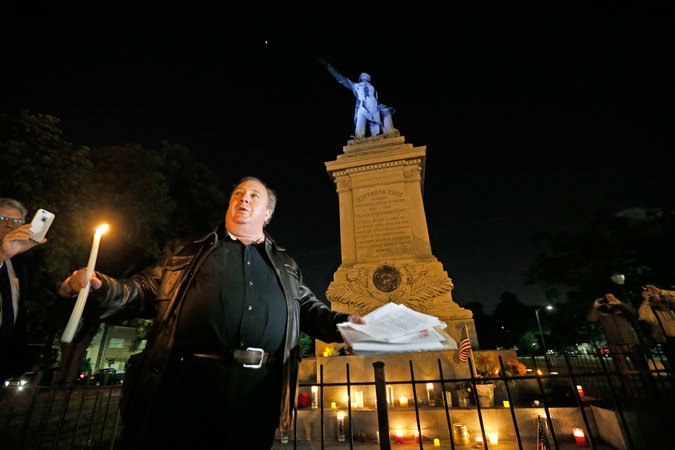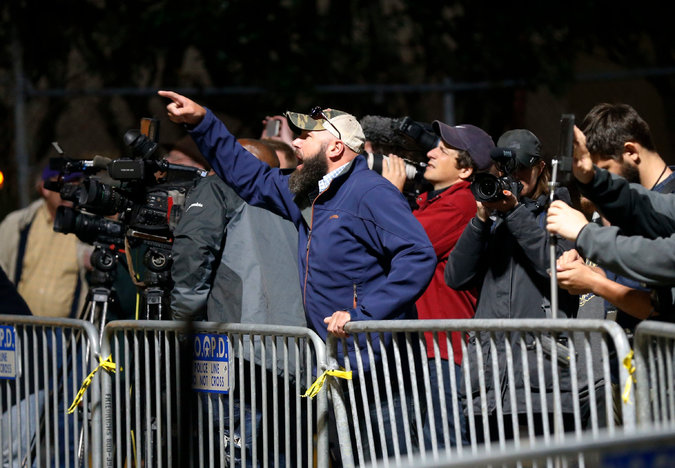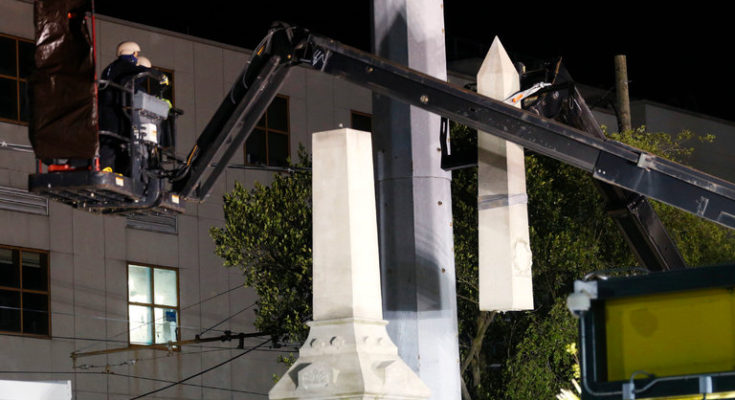New Orleans on Monday began removing four monuments dedicated to the era of the Confederacy and its aftermath, capping a prolonged battle about the future of the memorials, which critics deemed symbols of racism and intolerance and which supporters viewed as historically important.
Workers dismantled an obelisk, which was erected in 1891 to honor members of the “Crescent City White League” who in 1874 fought in the Reconstruction-era Battle of Liberty Place against the racially integrated New Orleans police and state militia, Mayor Mitch Landrieu said in a statement.
The monument, which was sometimes used as a rallying point by David Duke and the Ku Klux Klan, has stirred debate for decades. Local leaders unsuccessfully tried to remove it in 1981 and 1993.
The workers were dressed in flak jackets, helmets and scarves to conceal their identities because of concerns about their safety, The Associated Press reported. Police officers watched from a nearby hotel.
Pieces of the monument were put on a truck and hauled away.
Other monuments expected to be removed include a bronze statue of Gen. Robert E. Lee in a traffic circle, named Lee Circle, in the city’s central business district since 1884; an equestrian statue of P.G.T. Beauregard, a Confederate general, and one of Jefferson Davis, the president of the Confederacy.
Citing security risks and threats to contractors seeking to do the work, the city would not reveal details about the removal of the other statues
The monuments were erected decades after the Civil War ended by people who wanted to demonstrate that the South should feel no guilt in having fought the war, the mayor’s statement said.
“The removal of these statues sends a clear and unequivocal message to the people of New Orleans and the nation: New Orleans celebrates our diversity, inclusion and tolerance,” Mr. Landrieu said. “This is not about politics, blame or retaliation. This is not a naïve quest to solve all our problems at once. This is about showing the whole world that we as a city and as a people are able to acknowledge, understand, reconcile — and most importantly — choose a better future.”
The debate over Confederate symbols has taken center stage since nine people were killed at a black church in South Carolina in June 2015. South Carolina removed the Confederate battle flag, which flew at its State House for more than 50 years, and other Southern cities have considered taking down monuments.
Harcourt Fuller, an assistant professor of history at Georgia State University in Atlanta, and a scholar of national and regional symbolism, said in an email that supporters of the monuments see them as part of their “historical and cultural legacy that needs to be maintained and protected.
“We’re talking largely about these concrete symbols,” he added. “By themselves, they’re lifeless. They’re not living symbols. But we as citizens project our own historical values onto them.”
The Liberty Place monument commemorated a violent uprising by white Democrats against the racial integration of the city’s police force and the Republicans who governed Louisiana. The White League won the battle and forcibly removed the governor, but federal troops arrived three days later to return the governor to power.

Charles Lincoln speaks at a candlelight vigil at the statue of Jefferson Davis in New Orleans on Monday. Credit Gerald Herbert/Associated Press
The battle remained an important symbol to those who resisted Reconstruction, the period of transforming Confederate states after the Civil War. From 1932 until 1993, the monument bore a plaque that said, in part, that the “the national election of November 1876 recognized white supremacy in the South and gave us our state,” the city statement said.
In 1993, the City Council voted to remove the obelisk, but instead the plaque was covered with a new one that read: “In honor of those Americans on both sides who died in the Battle of Liberty Place” and called it “a conflict of the past that should teach us lessons for the future.”
It was once prominently perched in a main shopping era, but was relegated to a spot at the end of the French Quarter when it was removed for street work in 1989.
After moving the statues into storage, New Orleans will seek a museum or other site to house them. The city said it gained private funding to relocate the statues, though it did not say how much money it secured or identify its source.
The opposition to the monuments’ removal — expressed in op-ed articles, social media posts and shouting at public meetings — was vigorous. A group opposing their removal said it had collected 31,000 signatures for a petition.
Demonstrators gathered for a candlelight vigil on Monday as workers removed the Liberty Place monument.
Testy confrontation between pro-monument crowd and black lives matter activists at Jefferson Davis monument. pic.twitter.com/IbIpfflILD
— Danny Monteverde (@DCMonteverde) April 24, 2017
Robert Bonner, 63, who said he was a Civil War re-enactor, protested the monument’s removal. “I think it’s a terrible thing,” he told The A.P. “When you start removing the history of the city, you start losing money. You start losing where you came from and where you’ve been.”

One of the demonstrators who gathered on Monday as workers dismantled the Liberty Place monument. Credit Gerald Herbert/Associated Press
The removal happened on Confederate Memorial Day, which is formally observed by Alabama and Mississippi to commemorate those who died in the Civil War.
In December 2015, the City Council voted 6-1 to take the statues down. In January 2016, a federal judge dismissed an attempt by preservation groups and a chapter of the Sons of Confederate Veterans to stop their removal.
An organization dedicated to preserving monuments in New Orleans, the Monumental Task Committee, opposed removing the statues.
In a statement on Monday, Pierre McGraw, the group’s president, said the removal process had been “flawed since the beginning” and that the use of unidentified money reeks of “atrocious government.”
“People across Louisiana should be concerned over what will disappear next,” the statement added.
Professor Robin A. Lenhardt, a law professor at of the Center on Race, Law and Justice at Fordham Law School, said in an email that city officials should be concerned about where to go from here.
“Simply to remove the statutes without a plan for community engagement and discourse would be a mistake, a real missed opportunity,” she wrote.
(Courtesy of NY Times: By Christopher Mele and Daniel Victor contributed reporting)









